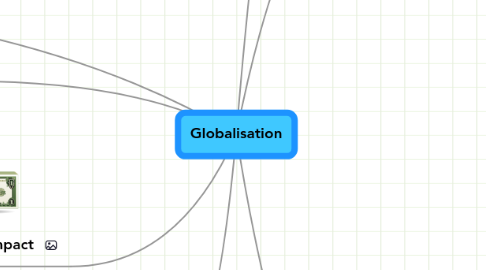
1. Allows capital inflows in both the manufacturing and financial markets
1.1. Sharing of technologies
1.1.1. Free trade allows for greater specialization of labour
2. Higher salaries
3. Economic Impact
3.1. Positive Impacts
3.1.1. Employment
3.1.1.1. Creation of jobs in LDCs esp in manufacturing industries
3.2. Negative Impact
3.2.1. Small countries face tough economic competition.
3.3. TNC controls the economy
3.4. Abuse of LDC. Formation of `sweat shops'
3.4.1. Affecting countries such as Bangladesh, Cambodia, Laos, Thailand,
3.5. Brain drain
3.6. Economies become vulnerable to impact of financial crisis caused by other countries
3.6.1. 2008 financial crisis started in USA
4. Educational Impact
4.1. Positive
4.1.1. Use of Technology to cater to the needs of the students
4.1.2. Able to have lessons beyond the physical classroom
4.1.3. Opportunities for Internationalisation
4.2. Negative
4.2.1. Stress on Teachers
4.2.2. Globalisation Divide: Haves and Have-Nots
5. Definition
6. Political Impacts
6.1. Role of United Nations
6.1.1. greater involvement in world events
6.1.1.1. Humanitarian efforts
6.1.1.2. Military intervention
6.1.1.3. Terrorism
6.2. Democratisation
6.2.1. Fall of regimes
6.2.1.1. Egypt
6.2.1.2. Libya
6.2.2. Change of leadership style
6.3. American Hegemony
6.3.1. World military and police force
6.3.1.1. terrorism
6.3.1.2. 'rogue' states
6.3.2. involvement in regional/domestic politics
6.3.2.1. Middle east
6.3.2.2. Korea
6.3.2.3. China-Taiwan
6.4. Role of Media
6.4.1. as political tool
6.4.2. as platform of discussion
6.5. Political lobby groups
6.5.1. power of internet
6.5.2. sharing ideas creating communities
7. Environmental Impact
7.1. Degradation
7.1.1. Deforestation
7.1.1.1. Soil erosion
7.1.1.2. Extinction of flora & fauna
7.1.1.3. Flooding
7.1.1.4. Haze
7.1.1.5. New node
7.1.2. Global Warming/Climate Change
7.1.2.1. Higher temperatures
7.1.2.2. Erratic Weather changes
7.1.2.3. Melting of ice caps
7.2. Management
7.2.1. Conserving Energy Supply
7.2.1.1. Energy saving products
7.2.1.1.1. Hybrid cars
7.2.2. Using Alternative Energy sources
7.2.2.1. Wind energy
7.2.2.2. Solar energy
7.2.2.3. Geothermal energy
